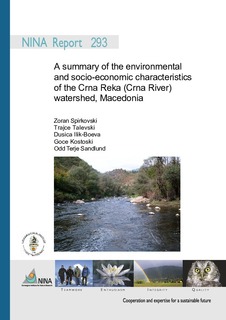| dc.description.abstract | Spirkovski, Z., Talevski, T., Ilik-Boeva, D., Kostoski, G. & Sandlund, O.T. 2007. Et sammendrag av kunnskapene om miljø og sosio-økonomiske forhold langs Crna Reka vassdraget, Makedonia. - NINA Report 293. 37 s + 12 annex.
Crna River (Crna Reka) is the biggest tributary to the Vardar River from the west. Vardar River is the biggest watercourse in the Republic of Macedonia, and drains into the Aegean Sea. The catchment area of Crna River is positioned between 20º 57’ – 22º 04’ E and 40º 50’ – 41º 36’ N at altitudes from 2601 m a.s.l. (Pelister) to 130 m a.s.l. at the confluence with Vardar River. Mean elevation of the catchment area is 630 m is above sea level. The catchment area of 5093 km2 includes twenty municipalities, with a total of 232,272 inhabitants. The water potential from the catchment area is 1001x106 m3. The climate zones are cold continental (60% of the area), continental-submediterranean (20%), and foothills continental mountaineous (20%). In the source areas of Crna River and its tributaries, typical representatives of flora and fauna communities associated with river sources are present. These communities include several species which are typical of clean unpolluted freshwaters. The flora and fauna along the major part of the river is, however, determined by the habitat types and the extent of human alteration of the natural conditions. Aquatic species diversity is seriously diminished in the middle and lower section of Crna River (through the Pelagonija plains and Tikvesh Valley) due to significant pollution of the waters by the inflow of communal and industrial sewage, as well as nutrients, sediments and pesticides in agricultural runoff. Major sources of pollution are the areas around the towns of Bitola and Priliep. Through the Skocivir ravine, the waters and biodiversity of Crna River is in a somewhat better condition due to the supply of fresh and clean mountain waters from the tributaries. The Tikvesh reservoir was created by the construction of a dam on the Crna River near the village of Vozarci, and has an increased species diversity due to the substantial water masses and the inflow of clean tributaries into the reservoir. The elevation of the reservoir is 260 m a.s.l., and the surface area is 1232.8 ha. Average, maximum and minimum flow in Crna River at the confluence with Vardar River is 22.4, 46.2 and 3.5 m3 / sec, respectively. Water quality in Macedonian water courses is mainly monitored by the Hydrometeorological Agency (HMA). Water quality classes are defined based on the concentration of a number of chemical and biological parameters (e.g. concentration of heavy metals, organic matter, etc., and bacterial content), according to the Macedonian Water Classification Regulative. The required water quality at various points in the Crna River water course has been established by law, but data from the monitoring programme show that the required quality level in many cases is not achieved. The European Fish Index (EFI) and ecological status for River Crna indicate that the upper part of the river, down to Bucin, at 650 m a.s.l., is characterized by rapid flow and salmonid-dominated fish community with a good ecological status. After the inflow of river Blato the ecological status deteriorates. The remaining downstream parts of the river have a moderate ecological status, except at the profile below the town of Bitola, which according the EFI has a bad ecological status. In the Skocivir canyon, the self-purification ability of the river brings the ecological status back to the moderate level all the way to the confluence with the river Vardar. Republic of Macedonia, Crna Reka watershed, summary of data, pollution, hydropower, fish community, bird fauna, Makedonia, Crna Reka vassdraget, datasammenfatning, forurensning, vannkraft, fiskesamfunn, fuglefauna | nb_NO |
